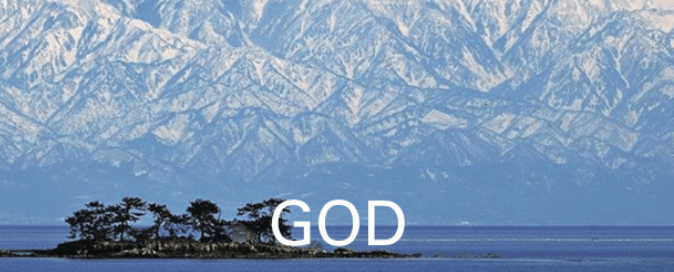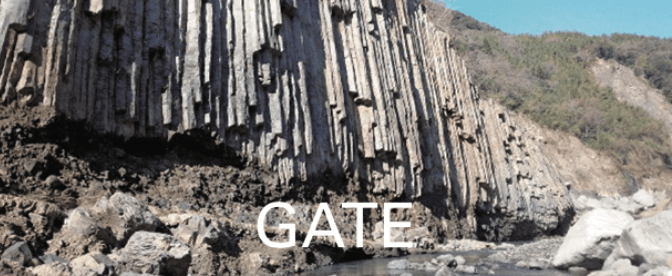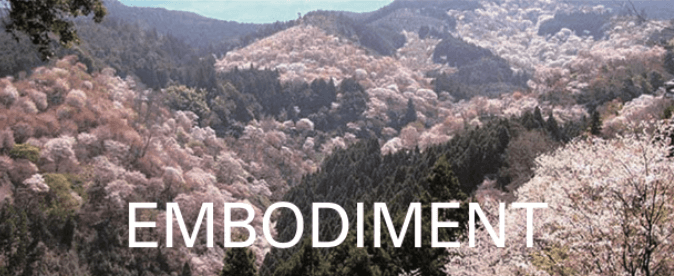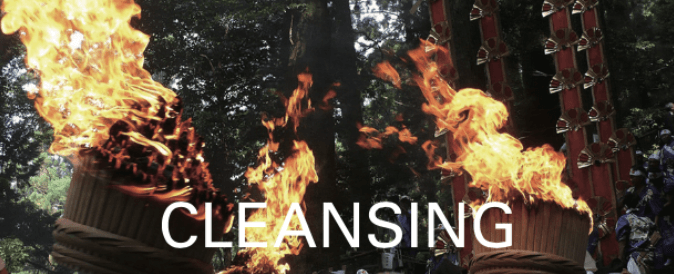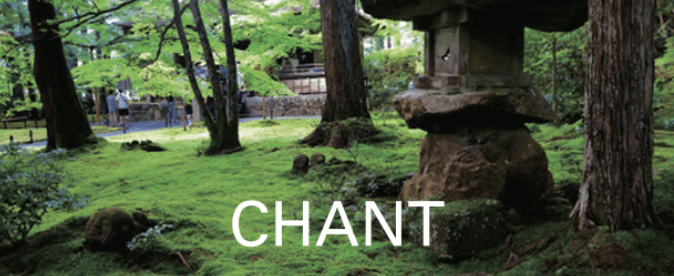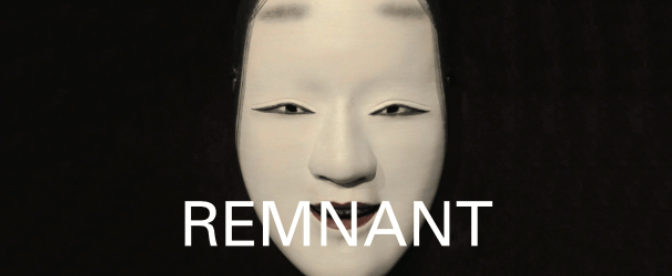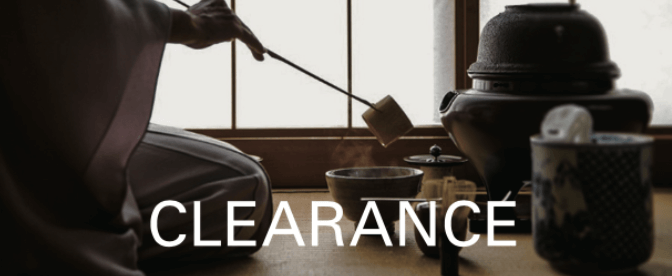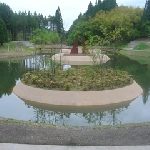
Mt. Murosan features pentagonal and hexagonal, column-shaped rocks, formed by ancient volcanic activity.
The garden has an art space of Dani Karavan (1930 – ), an Israeli sculptor best known for site specific memorials and monuments. His art is known for his magnificent sculptures that can interact with the sunlight and deep green nature with one’s five senses and integrate with the surrounding environment.
He says, “I was born in a holy land filled with memories in a stone and a piece of land.” He was able to read and understand the memories of Mt. Murosan.
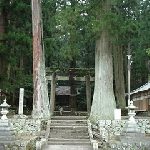
There is a giant tree by the side of the Torii: a gateway at the entrance to a shrine. A cedar entwined branches surround the worship hall, with its Irimoya Zukuri style building: the building with a hip-and-gable roof structure at the precinct.
This shrine has enshrined Ryujin (dragon god), which controls rain and cloud, since ancient times. It is located at the entrance to the valley about 1km from Muroji Temple, which was once the Jinguji Temple: a Buddhist temple within this shrine.
There is the Ryuketsu: the hole of Ryujin in its rear shrine, which is broken rocks enshrined with Shimenawa: sacred rice-straw ropes. The Imperial court has worshiped well the Ryujin and prayed for rain since the beginning of the Heian period (794 – 1185).
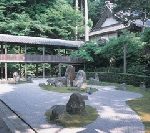
This temple near Hikonejo Castle is a Bodaiji temple with Ii family grave. Ii family had served the Minamoto clan since the Heian period (794 – 1185) and came from Mikawa Hamana Lake, where Ryotanji temple used to be and was famous for the garden by Kobori Enshu (1579 – 1647), a feudal lord, a master of the tea ceremony, an architect and garden designer. The Ii family moved the temple close to Hikonejo castle in the Edo period (1603 – 1868).
Hojo, the abbot’s chamber of this temple, has 104 sliding screen paintings, drawn by Morikawa Kyoriku (1656 – 1715), as one of Basho Jittetsu, the ten representative pupils under Matsuo Basho (1644 – 1694), the most famous poet of the Edo period. Those paintings deeply unite the aesthetic with the eastern garden.
Hojo’s southern garden has a group of 48 stones on white sand, which represents the Pure Land, Paradise of Mount Potalaka in the seas south of India, the mythical dwelling of Kannon, the Buddhist Goddess of Mercy. It used to be able to commute from the temple to Hikonejo Castle by boat.

This temple is an ancient temple which was founded in 651, by Hodo Senin, who came from India to Japan around the 6th -7th centuries and opened famous and Imperial temples in Harima and Setsu Provinces, Hogyo.
This National Treasure, the main temple, is typical Esoteric Buddhist temples in the Muromachi Period (1366 – 1573). It has Setchu-yo, Japanese-style architecture, with added elements of traditional Chinese-style architecture.
The main principal of this temple are two wooden statues of Senju Kannon, the Buddhist Goddess of Mercy with a 1,000 arms. One of the statues was made in the latter part of the Kamakura period (1185 – 1333) and was moved from Rengeoin Temle Sanjusangen-do, in Kyoto.
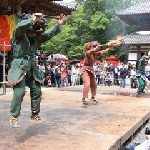
It is the ancient path of Mt. Mikusa, where you can see the waterfall named Tskubane, truelove flutters with four bracts. It leads to Chokoji Temple, where Shugendo, Japanese mountain ascetic practices, was thriving. The temple was founded in 651, by Hodo Senin, who came from India to Japan around the 6th -7th centuries and opened famous and Imperial temples in Harima and Setsu Provinces, Hogyo.
The temple has Onioi Odori, the dance performance with Okina, an old man and Oni, Ogres, to pray for the harvest and good health. The performance has continued since the Muromachi Period (1366 – 1573). This ancient path might be the footsteps of ancient immigrants who had developed the veins.
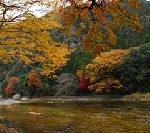
The Horaikyo Valley, which extends approximately 5km across the upper and the lower reach of the Uren River, is surrounded by beautiful mountains such as Mt. Horaiji.
You can fully enjoy the lively power of the forest that accumulates abundant water inside. You will get a powerful impression from the “Ukiishi Bridge” in the front of the waterfall.
-After Odai no Kata (1528 – 1602), mother of Tokugawa Ieyasu (1543 – 1616): the founder of the Tokugawa Shogunate, stayed at Houraiji Temple at Mt. Houraiji, which had been worshiped as a holy mountain, she had Ieyasu.
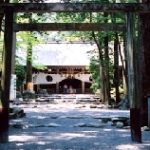
“Japanese style farming in a layered culture” -This shrine, represented by Mt. Nudougatake, enshrines the Great God Sarutahiko, who guides us to the prosperity land of native and exotic cultures. There is a sacred rice field, where rice is grown and is offered at Ise Jinguu Shrine, the Main shrine of the Great Goddess Amaterasu Oomikami: Sun Goddess and the Japanese Emperors are considered to be direct descendants of Amaterasu .
This shrine is the center of Shugendo, Japanese mountain ascetic practices, which was founded by Gyoman Daimyojin God, the founder of Shugendo, and the descendant of the Great God Sarutahiko.
There is a waterfall of Golden Dragon Myojin God in the precincts, and Shishigashira, the remains of a lion’s mask from a ritual dance, which is said to be dedicated by Kibi no makibi (695 – 775), a Japanese scholar and noble.
The ritual dance with Shishigashira in this shrine has a 1,300 year history. -It is said that when the gods’ party of the Great Goddess Amaterasu, landed Japan, the Great God Sarutahiko, guided them.
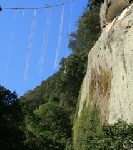
Kumano-nada Sea, the sea off the coast of Kumano, spreads out in the eastern part of the Kii Peninsula. The spectacular coastal beauty shaped by rough waves is made up of Columnar Joint, rock walls with numerous columns.
This shrine is for Izanami, a goddess in Japanese mythology who produced numerous gods and became the ruling goddess of the realm of the dead. Because this shrine sees the rock surface, which is said to be about 45m in height, as the Kura, a container for the soul of God.
There is the festival, which has the ritual song in front of the rocks, adorned with flowers and partakas (flags). It tells us that it was an ancient prayer form of the Japanese archipelago that followed the maritime road.

Iwami has a mysterious landscape of rock in the Tatamigakura area on the Togane coast of Kokubun Town, with round stone nodules that line up in parallel on the wave-cut platform. Rocks have also been the object of worship since ancient times. Kagura, was sacred music and dance in front of Iwato, a rock door, which invited the hidden Sun Goddess, Amaterasu Oomikami: Sun Goddess and the Japanese Emperors are considered to be direct descendants of Amaterasu, to go out.
The local Kagura is a village Kagura that expresses gratitude during the harvest season. You can see into the mythical world, through the Kagura, with the vigorous and fast-paced 8 beats.
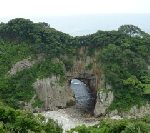
On the shoreline lit by the Cape Ashizuri Lighthouse, there is Hakusan Doumon, created by the marine erosion. It stands 16 m tall and 17 m wide. It is sea cave of granite which is the largest natural treasure in Japan. Even now you can get down to the basics that are washed in by the waves, but this sea cave was regarded as an object of worship since ancient times, and it was a symbol of religious training.
In the Medieval Ages, this cave was believed to be the eastern gate that lead to Mount Potalaka in the seas south of India, where the mythical dwelling of Kannnon, the Buddhist Goddess of Mercy.

61 Magaibutsu, Buddha statues in a natural rock wall, are designated as National Treasures. Many Magaibutsu were made, along with mountain worship, which did Shinbutsu-shugo, the syncretism of Shintoism and Buddhism, in the Heian period (794 – 1185). Usuki Magaibutsu were carved in the villages, not in the mountains, from the late Heian period to the Kamakura period (1185 – 1333).
At that time, the expressive appearance of the Buddha gives a peace of mind to the viewer. It is said that a rich person in the village made Usuki Magaibutsu. That taste is different from Magaibutsu in the mountains.
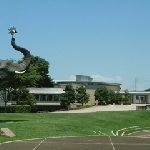
This museum is located at the top of the Uenono Forest on the hillock, and is a museum in the full of nature. It holds 7 to 8 special exhibitions a year. You can always enjoy Japanese modern and contemporary Japanese paintings, Bungo Nanga, Japanese Paintings of the literary school in the Edo period (1603 – 1868), paintings of the Southern Son Dynasty (1127 – 1279), in Bungo Province Oitta, Western paintings, bamboo crafts, contemporary art works, etc.
In addition to the museum shop and restaurant, there is a walking path with outdoor sculptures in the park, where you can enjoy nature observation and forest bathing.
– Tanomura Chikuden (1777 – 1835) was a painter of Bungo Nanga. He learned various styles from interacting with many people, such as Kimura Kenkado (1736 – 1802), a Japanese scholar artist and art connoisseur. And he reached the painting with delicate and profound aesthetics and created vigorously in his later years.
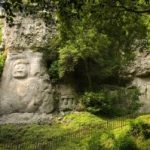
Kumano Magaibutsu, Buddha statues in a natural rock wall appears, after you climb the natural stone stairs roughly piled up on the mountain path of Taizoji Temple It is said that the Magaibutsu was made in the end of the Heian period (794 – 1185). There are Fudo Myoo, 8m tall Wisdom Kings to lead people with austerity, and 6m tall Dainichi Nyorai, the Supreme Buddha of the Cosmos and the central object in Esoteric sects of Buddhism, carved on the huge natural rock wall on the left side of the path. Those expressions are deep and calm.
This place is the starting point of Mineiri no Aragyo, a rigorous ascetic exercise of monks, to encounter sacred places in Kunisaki Peninsula, through steep roads and mountains. These are traditional events of Rokugo-Manzan, a group of Tendai sect temples in Kunisaki Peninsula.
The Magaibutsu and the event convey the history that Shinbutsu-shugo, the syncretism of Shintoism and Buddhism, began at Usajingu Shrine, Oita and spread to Kunisaki Peninsula in the Heian period (794 – 1185).
